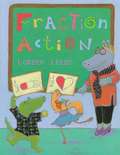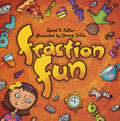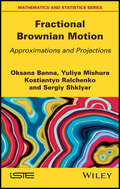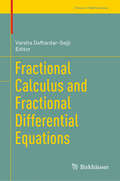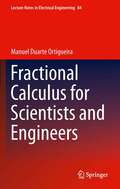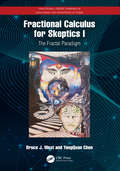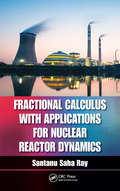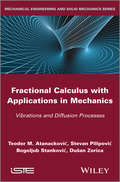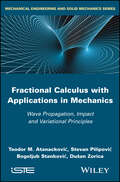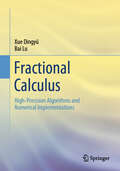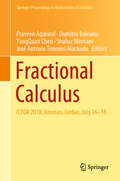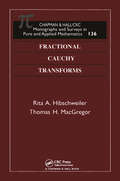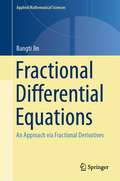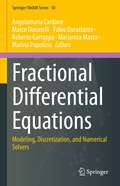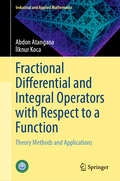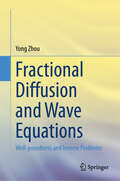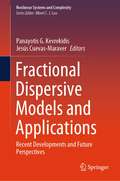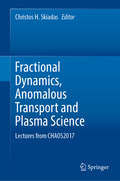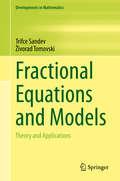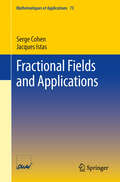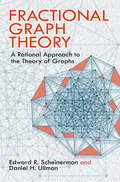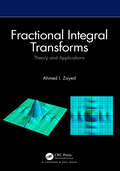- Table View
- List View
Fraction Fun
by David A. AdlerWould you rather eat 1/4 of a pizza or 1/8 of a pizza? Find 3/4 of a dollar or 1/10 of a dollar? Confused? You don't have to be! Fractions are made easy in this simple and hands-on math concept book. You'll learn what the top and bottom numbers are called, and what they mean. You will also find out how to recognize and compare different fractions. Just follow the clear instructions and you will learn the most important thing of all -- that fractions can be fun!
Fractional Brownian Motion: Approximations and Projections (Lecture Notes in Mathematics #1929)
by Yuliya Mishura Kostiantyn Ralchenko Oksana Banna Sergiy ShklyarThis monograph studies the relationships between fractional Brownian motion (fBm) and other processes of more simple form. In particular, this book solves the problem of the projection of fBm onto the space of Gaussian martingales that can be represented as Wiener integrals with respect to a Wiener process. It is proved that there exists a unique martingale closest to fBm in the uniform integral norm. Numerical results concerning the approximation problem are given. The upper bounds of distances from fBm to the different subspaces of Gaussian martingales are evaluated and the numerical calculations are involved. The approximations of fBm by a uniformly convergent series of Lebesgue integrals, semimartingales and absolutely continuous processes are presented. As auxiliary but interesting results, the bounds from below and from above for the coefficient appearing in the representation of fBm via the Wiener process are established and some new inequalities for Gamma functions, and even for trigonometric functions, are obtained.
Fractional Calculus and Fractional Differential Equations (Trends in Mathematics)
by Varsha Daftardar-GejjiThis book provides a broad overview of the latest developments in fractional calculus and fractional differential equations (FDEs) with an aim to motivate the readers to venture into these areas. It also presents original research describing the fractional operators of variable order, fractional-order delay differential equations, chaos and related phenomena in detail. Selected results on the stability of solutions of nonlinear dynamical systems of the non-commensurate fractional order have also been included. Furthermore, artificial neural network and fractional differential equations are elaborated on; and new transform methods (for example, Sumudu methods) and how they can be employed to solve fractional partial differential equations are discussed.The book covers the latest research on a variety of topics, including: comparison of various numerical methods for solving FDEs, the Adomian decomposition method and its applications to fractional versions of the classical Poisson processes, variable-order fractional operators, fractional variational principles, fractional delay differential equations, fractional-order dynamical systems and stability analysis, inequalities and comparison theorems in FDEs, artificial neural network approximation for fractional operators, and new transform methods for solving partial FDEs. Given its scope and level of detail, the book will be an invaluable asset for researchers working in these areas.
Fractional Calculus for Scientists and Engineers
by Manuel Duarte OrtigueiraThis book gives a practical overview of Fractional Calculus as it relates to Signal Processing
Fractional Calculus for Skeptics I: The Fractal Paradigm (Fractional Order Thinking in Exploring the Frontiers of STEM)
by Bruce J. West YangQuan ChenThis book is the first of its kind on fractional calculus (FC), dedicated to advocating for FC in STEM education and research.Fractional calculus is increasingly used today, but there remains a core population of skeptics regarding the utility of this "new" calculus. This book is intended for those who are skeptical about the need for fractional calculus to describe dynamic complex networks and must be convinced of its use on a case-by-case basis. It is a one-stop resource to rapidly read and replace the appropriate skepticism with new knowledge. It offers compelling reasons from the perspectives of the physical, social, and life sciences as to why fractional calculus is needed when addressing the complexity of an underlying STEM phenomenon. The six chapters are accompanied by useful and essential appendices and chapter-end references. Each includes new (fractional-order) ways of thinking about statistics, complexity dynamics, and what constitutes a solution to a complexity science problem.The book will appeal to students and researchers in all STEM-related fields, such as engineering, physics, biology and biomedicine, climate change, big data, and machine learning. It is also suitable for general readers interested in these fields.
Fractional Calculus in Medical and Health Science (Mathematics and its Applications)
by Devendra Kumar Jagdev SinghThis book covers applications of fractional calculus used for medical and health science. It offers a collection of research articles built into chapters on classical and modern dynamical systems formulated by fractional differential equations describing human diseases and how to control them. The mathematical results included in the book will be helpful to mathematicians and doctors by enabling them to explain real-life problems accurately. The book will also offer case studies of real-life situations with an emphasis on describing the mathematical results and showing how to apply the results to medical and health science, and at the same time highlighting modeling strategies. The book will be useful to graduate level students, educators and researchers interested in mathematics and medical science.
Fractional Calculus with Applications for Nuclear Reactor Dynamics
by Santanu Saha RayIntroduces Novel Applications for Solving Neutron Transport EquationsWhile deemed nonessential in the past, fractional calculus is now gaining momentum in the science and engineering community. Various disciplines have discovered that realistic models of physical phenomenon can be achieved with fractional calculus and are using them in numerous way
Fractional Calculus with Applications in Mechanics: Vibrations and Diffusion Processes
by Dusan Zorica Teodor M. Atanackovic Bogoljub Stankovic Stevan PilipovicThis book contains mathematical preliminaries in which basic definitions of fractional derivatives and spaces are presented. The central part of the book contains various applications in classical mechanics including fields such as: viscoelasticity, heat conduction, wave propagation and variational Hamilton–type principles. Mathematical rigor will be observed in the applications. The authors provide some problems formulated in the classical setting and some in the distributional setting. The solutions to these problems are presented in analytical form and these solutions are then analyzed numerically. Theorems on the existence of solutions will be presented for all examples discussed. In using various constitutive equations the restrictions following from the second law of thermodynamics will be implemented. Finally, the physical implications of obtained solutions will be discussed in detail.
Fractional Calculus with Applications in Mechanics: Wave Propagation, Impact and Variational Principles
by Dusan Zorica Teodor M. Atanackovic Bogoljub Stankovic Stevan PilipovicThe books Fractional Calculus with Applications in Mechanics: Vibrations and Diffusion Processes and Fractional Calculus with Applications in Mechanics: Wave Propagation, Impact and Variational Principles contain various applications of fractional calculus to the fields of classical mechanics. Namely, the books study problems in fields such as viscoelasticity of fractional order, lateral vibrations of a rod of fractional order type, lateral vibrations of a rod positioned on fractional order viscoelastic foundations, diffusion-wave phenomena, heat conduction, wave propagation, forced oscillations of a body attached to a rod, impact and variational principles of a Hamiltonian type. The books will be useful for graduate students in mechanics and applied mathematics, as well as for researchers in these fields.Part 1 of this book presents an introduction to fractional calculus. Chapter 1 briefly gives definitions and notions that are needed later in the book and Chapter 2 presents definitions and some of the properties of fractional integrals and derivatives.Part 2 is the central part of the book. Chapter 3 presents the analysis of waves in fractional viscoelastic materials in infinite and finite spatial domains. In Chapter 4, the problem of oscillations of a translatory moving rigid body, attached to a heavy, or light viscoelastic rod of fractional order type, is studied in detail. In Chapter 5, the authors analyze a specific engineering problem of the impact of a viscoelastic rod against a rigid wall. Finally, in Chapter 6, some results for the optimization of a functional containing fractional derivatives of constant and variable order are presented.
Fractional Calculus: High-Precision Algorithms and Numerical Implementations
by Dingyü Xue Lu BaiFractional calculus and its applications are fascinating research areas in many engineering disciplines. This book is a comprehensive collection of research from the author's group, which is one of the most active in the fractional calculus community worldwide and is the birthplace of one of the four MATLAB toolboxes in fractional calculus, the FOTF Toolbox. The book presents high-precision solution algorithms for a variety of fractional-order differential equations, including nonlinear, delay, and boundary value equations. Currently, there are no other universal solvers available for the latter two types of equations. Through this book, readers can systematically study the mathematics and solution methods in the field of fractional calculus and apply these concepts to different engineering fields, particularly control systems engineering.This book is a translation of an original German edition. The translation was done with the help of artificial intelligence (machine translation by the service DeepL.com). A subsequent human revision was done primarily in terms of content, so that the book will read stylistically differently from a conventional translation.
Fractional Calculus: ICFDA 2018, Amman, Jordan, July 16-18 (Springer Proceedings in Mathematics & Statistics #303)
by Dumitru Baleanu José António Tenreiro Machado Praveen Agarwal YangQuan Chen Shaher MomaniThis book collects papers presented at the International Conference on Fractional Differentiation and its Applications (ICFDA), held at the University of Jordan, Amman, Jordan, on 16–18 July 2018. Organized into 13 chapters, the book discusses the latest trends in various fields of theoretical and applied fractional calculus. Besides an essential mathematical interest, its overall goal is a general improvement of the physical world models for the purpose of computer simulation, analysis, design and control in practical applications. It showcases the development of fractional calculus as an acceptable tool for a large number of diverse scientific communities due to more adequate modeling in various fields of mechanics, electricity, chemistry, biology, medicine, economics, control theory, as well as signal and image processing. The book will be a valuable resource for graduate students and researchers of mathematics and engineering.
Fractional Cauchy Transforms (Monographs and Surveys in Pure and Applied Mathematics)
by Rita A. HibschweilerPresenting new results along with research spanning five decades. Fractional Cauchy Transforms provides a full treatment of the topic, from its roots in classical complex analysis to its current state. Self-contained, it includes introductory material and classical results, such as those associated with complex-valued measures on the unit circle, that form the basis of the developments that follow. The authors focus on concrete analytic questions, with functional analysis providing the general framework., After examining basic properties, the authors study integral means and relationships between the fractional Cauchy transforms and the Hardy and Dirichlet spaces. They then study radial and nontangential limits, followed by chapters devoted to multipliers, composition operators, and univalent functions. The final chapter gives an analytic characterization of the family of Cauchy transforms when considered as functions defined in the complement of the unit circle.
Fractional Differential Equations: An Approach via Fractional Derivatives (Applied Mathematical Sciences #206)
by Bangti JinThis graduate textbook provides a self-contained introduction to modern mathematical theory on fractional differential equations. It addresses both ordinary and partial differential equations with a focus on detailed solution theory, especially regularity theory under realistic assumptions on the problem data. The text includes an extensive bibliography, application-driven modeling, extensive exercises, and graphic illustrations throughout to complement its comprehensive presentation of the field. It is recommended for graduate students and researchers in applied and computational mathematics, particularly applied analysis, numerical analysis and inverse problems.
Fractional Differential Equations: Modeling, Discretization, and Numerical Solvers (Springer INdAM Series #50)
by Marco Donatelli Fabio Durastante Roberto Garrappa Angelamaria Cardone Mariarosa Mazza Marina PopolizioThe content of the book collects some contributions related to the talks presented during the INdAM Workshop "Fractional Differential Equations: Modelling, Discretization, and Numerical Solvers", held in Rome, Italy, on July 12–14, 2021. All contributions are original and not published elsewhere. The main topic of the book is fractional calculus, a topic that addresses the study and application of integrals and derivatives of noninteger order. These operators, unlike the classic operators of integer order, are nonlocal operators and are better suited to describe phenomena with memory (with respect to time and/or space). Although the basic ideas of fractional calculus go back over three centuries, only in recent decades there has been a rapid increase in interest in this field of research due not only to the increasing use of fractional calculus in applications in biology, physics, engineering, probability, etc., but also thanks to the availability of new and more powerful numerical tools that allow for an efficient solution of problems that until a few years ago appeared unsolvable. The analytical solution of fractional differential equations (FDEs) appears even more difficult than in the integer case. Hence, numerical analysis plays a decisive role since practically every type of application of fractional calculus requires adequate numerical tools. The aim of this book is therefore to collect and spread ideas mainly coming from the two communities of numerical analysts operating in this field - the one working on methods for the solution of differential problems and the one working on the numerical linear algebra side - to share knowledge and create synergies. At the same time, the book intends to realize a direct bridge between researchers working on applications and numerical analysts. Indeed, the book collects papers on applications, numerical methods for differential problems of fractional order, and related aspects in numerical linear algebra.The target audience of the book is scholars interested in recent advancements in fractional calculus.
Fractional Differential and Integral Operators with Respect to a Function: Theory Methods and Applications (Industrial and Applied Mathematics)
by Abdon Atangana İlknur KocaThis book explores the fundamental concepts of derivatives and integrals in calculus, extending their classical definitions to more advanced forms such as fractional derivatives and integrals. The derivative, which measures a function's rate of change, is paired with its counterpart, the integral, used for calculating areas and volumes. Together, they form the backbone of differential and integral equations, widely applied in science, technology, and engineering. However, discrepancies between mathematical models and experimental data led to the development of extended integral forms, such as the Riemann–Stieltjes integral and fractional integrals, which integrate functions with respect to another function or involve convolutions with kernels. These extensions also gave rise to new types of derivatives, leading to fractional derivatives and integrals with respect to another function. While there has been limited theoretical exploration in recent years, this book aims to bridge that gap. It provides a comprehensive theoretical framework covering inequalities, nonlinear ordinary differential equations, numerical approximations, and their applications. Additionally, the book delves into the existence and uniqueness of solutions for nonlinear ordinary differential equations involving these advanced derivatives, as well as the development of numerical techniques for solving them.
Fractional Diffusion Equations And Anomalous Diffusion
by Luiz Roberto Evangelista Ervin Kaminski LenziAnomalous diffusion has been detected in a wide variety of scenarios, from fractal media, systems with memory, transport processes in porous media, to fluctuations of financial markets, tumour growth, and complex fluids. Providing a contemporary treatment of this process, this book examines the recent literature on anomalous diffusion and covers a rich class of problems in which surface effects are important, offering detailed mathematical tools of usual and fractional calculus for a wide audience of scientists and graduate students in physics, mathematics, chemistry and engineering. Including the basic mathematical tools needed to understand the rules for operating with the fractional derivatives and fractional differential equations, this self-contained text presents the possibility of using fractional diffusion equations with anomalous diffusion phenomena to propose powerful mathematical models for a large variety of fundamental and practical problems in a fast-growing field of research.
Fractional Diffusion and Wave Equations: Well-posedness and Inverse Problems
by Yong ZhouThis monograph delves into the theory of time-fractional diffusion and wave equations, presenting a comprehensive exploration of recent advancements in the field. Key topics include well-posedness, regularity, and approximate controllability of Cauchy problems, as well as the existence and regularity of terminal value problems. Detailed examples illustrate the applications of these equations, demonstrating their practical relevance. The content is rooted in research conducted by the author and other experts over the past five years, offering a thorough foundation for further study. This work is an invaluable resource for researchers, graduate students, and PhD candidates in the fields of differential equations, applied analysis, and related areas.
Fractional Dispersive Models and Applications: Recent Developments and Future Perspectives (Nonlinear Systems and Complexity #37)
by Jesús Cuevas-Maraver Panayotis G. KevrekidisThis book explores the role of fractional calculus and associated partial differential equations in modeling multiscale phenomena and overlapping macroscopic & microscopic scales, offering an innovative and powerful tool for modeling complex systems. While integer order PDEs have a long-standing history, the novel setting of fractional PDEs opens up new possibilities for the simulation of multi-physics phenomena. The book examines a range of releavant examples that showcase the seamless transition from wave propagation to diffusion or from local to non-local dynamics in both continuum and discrete systems. These systems have been argued as being particularly relevant in contexts such as nonlinear optics, lattice nonlinear dynamical systems, and dispersive nonlinear wave phenomena, where the exploration of the potential fractionality has emerged as a highly active topic for current studies.The volume consists of contributions from a diverse group of active scholars and expertsacross different fields, providing a detailed examination of the field's past, present, and future state-of-the-art in the interplay of fractional PDEs and nonlinear wave phenomena. It is intended to be of wide interest to both seasoned researchers and beginners in the Field of Nonlinear Science. This book sets the stage for the next decade of research and beyond and is a timely and relevant reference of choice for this crucial junction of current research.
Fractional Dynamic Calculus and Fractional Dynamic Equations on Time Scales
by Svetlin G. GeorgievPedagogically organized, this monograph introduces fractional calculus and fractional dynamic equations on time scales in relation to mathematical physics applications and problems. Beginning with the definitions of forward and backward jump operators, the book builds from Stefan Hilger’s basic theories on time scales and examines recent developments within the field of fractional calculus and fractional equations. Useful tools are provided for solving differential and integral equations as well as various problems involving special functions of mathematical physics and their extensions and generalizations in one and more variables. Much discussion is devoted to Riemann-Liouville fractional dynamic equations and Caputo fractional dynamic equations. Intended for use in the field and designed for students without an extensive mathematical background, this book is suitable for graduate courses and researchers looking for an introduction to fractional dynamic calculus and equations on time scales.
Fractional Dynamics, Anomalous Transport and Plasma Science: Lectures From Chaos2017
by Christos H. SkiadasThis book collects interrelated lectures on fractal dynamics, anomalous transport and various historical and modern aspects of plasma sciences and technology. The origins of plasma science in connection to electricity and electric charges and devices leading to arc plasma are explored in the first contribution by Jean-Marc Ginoux and Thomas Cuff. The second important historic connection with plasmas was magnetism and the magnetron. Victor J. Law and Denis P. Dowling, in the second contribution, review the history of the magnetron based on the development of thermionic diode valves and related devices. In the third chapter, Christos H Skiadas and Charilaos Skiadas present and apply diffusion theory and solution strategies to a number of stochastic processes of interest. Anomalous diffusion by the fractional Fokker-Planck equation and Lévy stable processes are studied by Johan Anderson and Sara Moradi in the fourth contribution. They consider the motion of charged particles in a 3-dimensional magnetic field in the presence of linear friction and of a stochastic electric field. Analysis of low-frequency instabilities in a low-temperature magnetized plasma is presented by Dan-Gheorghe Dimitriu, Maricel Agop in the fifth chapter. The authors refer to experimental results of the Innsbruck Q-machine and provide an analytical formulation of the related theory. In chapter six, Stefan Irimiciuc, Dan-Gheorghe Dimitriu, Maricel Agop propose a theoretical model to explain the dynamics of charged particles in a plasma discharge with a strong flux of electrons from one plasma structure to another. The theory and applications of fractional derivatives in many-particle disordered large systems are explored by Z.Z. Alisultanov, A.M. Agalarov, A.A. Potapov, G.B. Ragimkhanov. In chapter eight, Maricel Agop, Alina Gavrilut¸ and Gabriel Crumpei explore the motion of physical systems that take place on continuous but non-differentiable curves (fractal curves). Finally in the last chapter S.L. Cherkas and V.L. Kalashnikov consider the perturbations of a plasma consisting of photons, baryons, and electrons in a linearly expanding (Milne-like) universe taking into account the metric tensor and vacuum perturbations.
Fractional Equations and Models: Theory and Applications (Developments in Mathematics #61)
by Trifce Sandev Živorad TomovskiFractional equations and models play an essential part in the description of anomalous dynamics in complex systems. Recent developments in the modeling of various physical, chemical and biological systems have clearly shown that fractional calculus is not just an exotic mathematical theory, as it might have once seemed. The present book seeks to demonstrate this using various examples of equations and models with fractional and generalized operators. Intended for students and researchers in mathematics, physics, chemistry, biology and engineering, it systematically offers a wealth of useful tools for fractional calculus.
Fractional Fields and Applications
by Serge Cohen Jacques IstasThis book focuses mainly on fractional Brownian fields and their extensions. It has been used to teach graduate students at Grenoble and Toulouse's Universities. It is as self-contained as possible and contains numerous exercises, with solutions in an appendix. After a foreword by Stéphane Jaffard, a long first chapter is devoted to classical results from stochastic fields and fractal analysis. A central notion throughout this book is self-similarity, which is dealt with in a second chapter with a particular emphasis on the celebrated Gaussian self-similar fields, called fractional Brownian fields after Mandelbrot and Van Ness's seminal paper. Fundamental properties of fractional Brownian fields are then stated and proved. The second central notion of this book is the so-called local asymptotic self-similarity (in short lass), which is a local version of self-similarity, defined in the third chapter. A lengthy study is devoted to lass fields with finite variance. Among these lass fields, we find both Gaussian fields and non-Gaussian fields, called Lévy fields. The Lévy fields can be viewed as bridges between fractional Brownian fields and stable self-similar fields. A further key issue concerns the identification of fractional parameters. This is the raison d'être of the statistics chapter, where generalized quadratic variations methods are mainly used for estimating fractional parameters. Last but not least, the simulation is addressed in the last chapter. Unlike the previous issues, the simulation of fractional fields is still an area of ongoing research. The algorithms presented in this chapter are efficient but do not claim to close the debate.
Fractional Graph Theory: A Rational Approach to the Theory of Graphs (Dover Books on Mathematics #Vol. 46)
by Daniel H. Ullman Prof. Edward R. ScheinermanA unified treatment of the most important results in the study of fractional graph concepts, this volume explores the various ways in which integer-valued concepts can be modified to derive nonintegral values. It begins with the general fractional theory of hypergraphs and presents in-depth coverage of fundamental and advanced topics. Subjects include fractional matching, fractional coloring, fractional edge coloring, fractional arboricity via matroid methods, and fractional isomorphism. The final chapter examines additional topics such as fractional domination, fractional intersection numbers, and fractional aspects of partially ordered sets.Challenging exercises reinforce the contents of each chapter, and the authors provide substantial references and bibliographic materials. A comprehensive reference for researchers, this volume also constitutes an excellent graduate-level text for students of graph theory and linear programming.
Fractional Integral Transforms: Theory and Applications
by Ahmed I. ZayedFractional Integral Transforms: Theory and Applications presents over twenty-five integral transforms, many of which have never before been collected in one single volume. Some transforms are classic, such as Laplace, Fourier, etc, and some are relatively new, such as the Fractional Fourier, Gyrator, Linear Canonical, Special Affine Fourier Transforms, as well as, continuous Wavelet, Ridgelet, and Shearlet transforms.The book provides an overview of the theory of fractional integral transforms with examples of such transforms, before delving deeper into the study of important fractional transforms, including the fractional Fourier transform. Applications of fractional integral transforms in signal processing and optics are highlighted. The book’s format has been designed to make it easy for readers to extract the essential information they need to learn the about the fundamental properties of each transform. Supporting proofs and explanations are given throughout.Features Brings together integral transforms never before collected into a single volume A useful resource on fractional integral transforms for researchers and graduate students in mathematical analysis, applied mathematics, physics and engineering Written in an accessible style with detailed proofs and emphasis on providing the reader with an easy access to the essential properties of important fractional integral transforms Ahmed I. Zayed is a Professor of Mathematics at the Department of Mathematical Sciences, DePaul University, Chicago, and was the Chair of the department for 20 years, from 2001 until 2021. His research interests varied over the years starting with generalized functions and distributions to sampling theory, applied harmonic analysis, special functions and integral transforms. He has published two books and edited seven research monographs. He has written 22 book chapters, published 118 research articles, and reviewed 173 publications for the Mathematical Review and 81 for the Zentralblatt für Mathematik (zbMath). He has served on the Editorial Boards of 22 scientific research journals and has refereed over 200 research papers submitted to prestigious journals, among them are IEEE, SIAM, Amer. Math. Soc., Math Physics, and Optical Soc. Journals.
